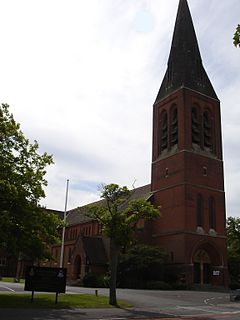A titular bishop in various churches is a bishop who is not in charge of a diocese. By definition, a bishop is an "overseer" of a community of the faithful, so when a priest is ordained a bishop, the tradition of the Roman Catholic and Orthodox churches is that he be ordained for a specific place. There are more bishops than there are functioning dioceses. Therefore, a priest appointed not to head a diocese as its diocesan bishop but to be an auxiliary bishop, a papal diplomat, or an official of the Roman Curia is appointed to a titular see.
The Archbishop of Nazareth is a former residential Metropolitan see, first in the Holy Land, then in Apulian exile in Berletta, which had a Latin and a Maronite successor as titular sees, the first merged into Barletta, the second suppressed.
The Roman Catholic Diocese of Prizren and Prishtina is an ecclesiastical territory or Diocese of the Roman Catholic Church in Kosovo. It is centred in the city of Prizren. It was erected as an Apostolic Administration in 2000, after being split from the Diocese of Skopje and Prizren and elevated in rank of Diocese in 2018.
Delkos, or Delcus, was a town of ancient Thrace. Under the name of Delcus it was a bishopric and later a titular see, now suppressed, of the Roman Catholic Church. It later called Dercos, under which name it again was a bishopric and later a titular see of the Roman Catholic Church. The Orthodox diocese remains extant.

The Roman Catholic Diocese of Beverley is an historical diocese of the Roman Catholic Church in England. It took its name after the town of Beverley in the East Riding of Yorkshire, although the episcopal see was located in the city of York. The diocese was established in 1850 and was replaced by two dioceses in 1878: Middlesbrough and Leeds. It was restored as a titular see in 1969.

The Bishopric of the Forces is the Latin Church Catholic military ordinariate which provides chaplains to the British Armed Forces based in the United Kingdom and their overseas postings.
Bergule or Bergula or Bergoule, also Bergulium or Bergoulion (Βεργούλιον), also called Bergulae or Virgulae, was a town in ancient Thrace, which was in later times called Arcadiopolis, Arcadiupolis, or Arkadioupolis (Ἀρκαδιούπολις). It was noted by Ptolemy, and inhabited during Roman and Byzantine times. Under the name Arcadiopolis in Europa it was the seat of a bishop; no longer a residential see, it remains a titular see of the Roman Catholic Church.

The Roman Catholic Diocese of Concordia in America was founded on August 2, 1887 by Pope Leo XIII and based in Concordia, Kansas. On December 23, 1947, the Diocese was renamed the Roman Catholic Diocese of Salina. In 1995, the Diocese of Concordia was restored as a titular see.
Anineta, also known as Aninetum or Anineton, was a town of ancient Lydia or of Caria, and later of the Roman, and Byzantine empires, located in modern Turkey, the site of an ancient bishopric in and was an important site early in christianity. Anineta remains today a titular see of the Roman Catholic Church in the ecclesiastical province of Ephesus. In addition it minted coins bearing the legend Ἀνινησίων.
Alessandro di Sangro was a Roman Catholic prelate who served as Archbishop of Benevento (1616–1633) and Titular Patriarch of Alexandria (1604–1633)
The Diocese of Modon or Medone was a "Latin" diocese located in the town of Modon in Messenia in the Peloponnese region of Greece. It was established in place of the pre-existing Greek Orthodox see in the aftermath of the Fourth Crusade, with the creation of the Principality of Achaea and the establishment of Venetian rule over Modon in 1209.

Satala or Satala in Lydia was a Roman era city and Bishopric in ancient Lydia.
Giovanni Battista Albani was a Roman Catholic prelate who served as Patriarch of Alexandria (1586–1588).
The Diocese of Chiron or Diocese of Chersonissos was a Roman Catholic diocese located in the town of Chersonissos in the north of Crete, bordering the Aegean Sea. In 1787, it was suppressed and became a Titular Episcopal See.
Petrus Draghi Bartoli was a Roman Catholic prelate who served as Titular Patriarch of Alexandria (1690–1695).

Aloysius Bevilacqua (1618–1679) was a Roman Catholic prelate who served as Titular Patriarch of Alexandria (1675–1680).
Ceretapa or Keretapa, also called Diocaesarea or Diocaesareia or Diokaisareia (Διοκαισάρεια), was a Graeco-Roman town of Phrygia Pacatiana. It minted coins bearing the demonym Κερεταπεύς. The coins also show that there was near it a river or fountain Aulindenus. It was a bishopric with Silvanus representing the city at the Council of Ephesus, 431. No longer the seat a residential bishop, it remains a titular see of the Roman Catholic Church.
Lupadium or Loupadion was a Graeco-Roman town of ancient Mysia. It minted coins during the Byzantine period. It was a bishopric; no longer the seat a residential bishop, it remains a titular see of the Roman Catholic Church.
Prymnessus or Prymnessos, or Prymnesus or Prymnesos (Πρύμνησος), was a town of ancient Phrygia, inhabited during Roman and Byzantine times. It was the see of a Christian bishop. No longer the seat of a residential bishop, it remains a titular see of the Roman Catholic Church.





